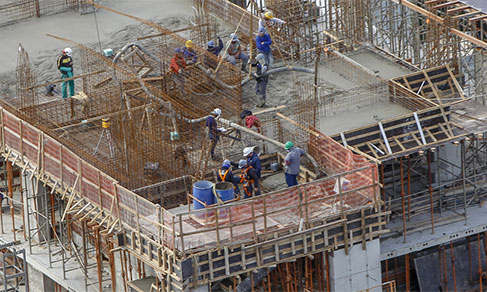Continuous PNAD
Average unemployment rate falls to 9.3% in 2022 - the lowest level since 2015
February 28, 2023 09h00 AM | Last Updated: March 01, 2023 05h11 PM

The unemployment rate reached 7.9% in the quarter ended in deember 20220 - a retreat of 0.8 percentage points (pp) in comparison with the quarter form July to September. As a result, the annual average of the index was of 9.3% in the year - which represents a reduction of 3.9 pp over that of 2021, which had been 13.2%. These data can be found in the Continuous National Household Sample Survey (Continuous PNAD), released today (Feb 28) by the IBGE.
The annual result is the lowest since 2015, showing that the labor market not only confirms the recovery trend after the impact of the COVID-19 pandemic, but also surpasses the pre-pandemic level. “The year 2021 was a transition, leaving the worst moment of the time series, under the impact of the pandemic and social distancing in 2020. The year 2022, in turn, marks the consolidation of recovery”, says Adriana Beringuy, coordinator of Labor and Income at the IBGE. “in two years, unemployment in the labor market retreated 4.5 pp”, she estimates. Despite the recovery compared to the latest years, the unemployment rate is still 2.4 pp above the lowest level of the series, recorded in 2014 (6.9%).
As a confirmation of the 2022 recovery, other indexes also stood out. The average annual rate of the employed population grew 7.4% in comparison with 2021, an increase of 6.7 million persons adding up to 98 million. The employment- population ratio also grew for the second consecutive year, after the lowest level in 2020 (51.2%) and recorded 56.6% in 2022.
Number of workers without a formal contract hits record in 2022
The year 2022 also recorded a rise in the number of workers with formal a contract. Formal contracts rose 9.2% and reached 35.9 million persons, consolidating the recovery trend started in 2021. “Though it has grown in the two last years, the index is still not enough to reach the level of 2014, the highest of the series”, stresses Ms. Beringuy. In 2014, the estimate of the annual rate reached 37.6 million of workers with a formal labor contract in the private sector.
The annual rate of workers without a formal labor contract also increased from 2021 to 2022: 14.9%, growing from 11.2 to 12.9 million persons, reaching its highest level in the time series. “In the last two years, we could see growth of employment with a formal contract and without a formal contract. However, the pace of growth stands out in the group of workers without a formal contract”, explains the expert.
The number of domestic workers rose 12.2% in 2022, reaching 5.8 million persons, while the number of employers reached 4.2 million, also a growth of 12.2% compared to 2021. Self-employed workers totaled 25.5 million, up 2.6% from 2021 to 2022.
Trade and services lead increase; Agriculture is the only sector to decrease in the year
The growth in the labor market between 2021 and 2022 was spread over the several economic activities. The highlights were Trade, repair of motor vehicles and motorcycles, which accrued gain of 9.4% (1.6 million more persons) and reached nearly 18.9 million persons employed in the sector. The activity of “other services” was the one with the highest percentage of increase of the employed population, 17.8%, reaching 5.2 million workers. The second highest increase was that of Lodging and food, which grew 15.8% and had its number of employed persons achieve 5.4 million.
Just the sector of Agriculture, livestock, forestry, fishery and aquaculture had percentage decrease of the employed population (-16%). The estimate is that 8.7 million of workers were employed in the in the sector in 2022.
In 2022, average earnings retreat and informality grows
The annual average value of the usual real earnings closed a at R$ 2.715, which represents 1% less than that of 2021, a loss of R$ 28. The annual average wage bill reached R$ 261.3 billion and hit the highest level in the series, up 6.9% (R$ 16.9 billion more) compared to 2021.
The Continuous PNAD also recorded a drop in the average annual rate of informality, which went from 40.1% in 2021 to 39.6% in 2022. “Despite the reduction, the rate still exceeds the rates of the beginning of the series in 2016 (38.6% ) and of 2020 (38.3%).
Closing the year at an average of 20.8%, the composite underutilization rate decreased by 6.4 p.p. compared to 2021 (27.2%), while the annual average of the underutilized population (24.1 million persons in 2022) decreased by 23.2% compared to 2021.
Quarter ended in December drops in unemployment and underutilization
Considering only the index for the quarter from October to December 2022, the Continuous PNAD released today shows that the unemployment rate (7.9%) was 0.8 pp lower than that of the quarter from July to September 2022 (8.7%) and 3.2 pp lower than that of the same quarter of 2021 (11.1%). The composite underutilization rate (18.5%) also dropped: 1.6 pp compared to the previous quarter (20.1%) and 5.8 pp compared to the same quarter of 2021 (24.3%).
The unemployed population reached 8.6 million persons, a drop of 9.4% (888 thousand less persons) compared to the quarter ended in September and a decrease of 28.6% (3.4 million less persons) compared to the same moving quarter of 2021. The employed population reached 99.4 million persons, showing stability in the comparison with the quarter ended in September, but with an increase of 3.8% (3.6 million persons) compared to the same quarter of 2021.
Finally, the employment level in December 2022 was 57.2%, equaling that of the previous quarter (57.2%) and rising 1.6 pp in the year (55.6%).
More about the survey
The Continuous PNAD is the main instrument to monitor workforce in Brazil. The survey sample per quarter corresponds to 211 thousand households surveyed in Brazil. Nearly two thousand interviewers work in the survey in 26 states and in the Federal District, integrated to the data collection network of more than 500 IBGE branches.
Due to the Covid-19 pandemic, the IBGE implemented data collection by telephone on March 17, 2020. In July 2021, face-to-face data collection was resumed. The ID of the interviewers can be confirmed at the Answering the IBGE website or through the Call Center (0800 7218181) by checking their ID numbers, which can be requested by the respondents. See PNAD data at Sidra database.




















